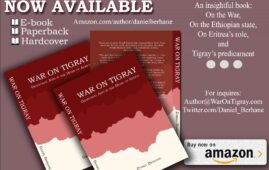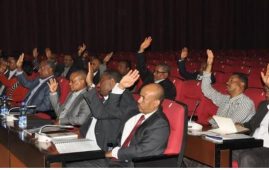The Los Angeles Times, a respected newspaper, carried a story entitled ‘The Nile, Egypt’s lifeline in the desert, comes under threat’ on November 10th under the byline of Jeffrey Fleishman. The title of the article underlines its theme – an old, well-beaten (and totally inaccurate), claim of an Egypt threatened by sinister upper riparian countries with no legitimate right to use the Nile waters. It is ridiculous that a writer of such a paper as the Los Angeles Times can still fall for this nonsensical age-old myth that Abyssinia might one day divert the Nile waters and dry up Egypt. Its sheer falsity has been proven over millennia despite all the fears that used to haunt Egyptian elites. Ethiopia contributes 85% of the Nile Water but all it has ever required is just and equitable use of the water. This has not changed throughout its long history whatever government has been in power. The plan to build the Grand Ethiopian Renaissance Dam makes no exception in this regard. It will not threaten Egypt’s use of the River.
Jeffrey Fleishman, however, comes up with convoluted arguments and inflammatory rhetoric to portray Egypt as a powerless nation whose survival is under real threat. Much of his argument is in fact simply wrong. He claims, for example: “African countries at the river’s source, notably Ethiopia, no longer feel bound by colonial-era agreements on water rights and are moving to siphon away larger shares of water for electricity, irrigation and business to meet demands of burgeoning populations”. In fact, of course, Ethiopia never signed any binding treaty with Egypt and Sudan on sharing the Nile water. Ethiopia has consistently opposed the colonial-era division of the water between Sudan and Egypt which totally disregarded the interests of the upper riparian countries. Indeed, at the time of the 1959 agreement, Ethiopia sent a critical aide memoire on the subject to all diplomatic missions in Cairo. Ethiopia and other riparian countries did not previously implement any projects on the Nile. This was not because they accepted the 1929 and 1959 agreements. They were unable to use the water because of economic problems, political instability and, most importantly, because of the refusal of the world’s biggest financial institutions to provide assistance. In addition, there was the continued intransigent demand by the lower riparian states that the status quo must continue to be maintained. Any suggestion that upper riparian countries accepted colonial era treaties, tacitly or otherwise, is completely wrong. Now, of course, things have changed. Indeed, although Mr. Fleishman appears not to have noticed, the world has changed. These old treaties have lost their relevance under current norms of international law.
Mr. Fleishman argues that “The biggest challenge to Cairo is the Grand Ethiopian Renaissance Dam. Experts estimate that the hydropower project, which is under construction and is expected to cost at least $4.8 billion, could reduce the river’s flow to Egypt by as much as 25% during the three years it would take to fill the reservoir behind the dam.” This ignores the fact that Ethiopia as a riparian state has a right to use the water in accordance with the principle of “equitable and reasonable utilization” of the water, the basis of the
Comprehensive Framework Agreement, which enjoys wide support under international water laws. Mr. Fleishman also fails to provide any source for the claim of a 25% loss of water, a claim for which there is no evidence, and which also ignores the fact that both Sudanese and Egyptian scholars and hydrologists have noted that the construction of the dam will have such benefits as significantly reducing the loss caused by evaporation from Lake Nasser, cutting the siltation in dams lower down the river, and the maintenance of a regular flow of water to downstream countries.
Mr. Fleishman entirely ignores any facts that provide alternative views to his alarmist beating of the drums of war. A more sober, and accurate, analysis would note the cooperation that has become visible between Ethiopia, Egypt and Sudan, in their participation in the International Panel of Experts to study if the Dam might offer any harm to downstream countries. Another positive development is the recent resumption of Egypt and Sudan’s participation in the Eastern Nile Technical Regional Office. There have been a number of other more understanding statements from Egyptian scholars and politicians in recent months.
Equally surprising, perhaps, is the way Mr. Fleishman presents the death of the late Prime Minister Meles as a major setback to the Grand Ethiopian Renaissance Dam project. One of the more obvious and visible points, clearly visible on all Ethiopian media outlets and in all government and private announcements and writings was the very clear resolve to ensure the success and completion of the Renaissance Dam. The death of Prime Minister Meles, who initiated the idea of the Dam, was a real loss, but the effect has only been to harden the resolution of the people to bring the project to a successful end. The evidence is clear in the continuing purchase of bonds and of repeated donations to fund the project.
Mr. Fleishman appears to have been trying to make an “appeal to sympathy” for a thirsting Egypt threatened by Ethiopia, fanning rhetoric of conflict or war. It is an approach that can have the effect of exacerbating suspicion and mistrust, but these are dead ideas. This sort of vituperation, aimed at rekindling a haunting specter of dead ideas, should have no place today. It is outdated and false. The Grand Ethiopian Renaissance Dam is a spectacular project which will profit Ethiopia, Egypt and Sudan, and will benefit the development of all three countries, directly and indirectly. It is a project that will provide for the mutual benefit and prosperity of all three states.
**************
* Originally published on A Week in the Horn – Nov. 16, 2012 issue, titled “Nile: Rehashing old and jaundiced views about the Nile”. Items from A Week in the Horn are re-published here with a permission to do so.
Check the drop down menu for posts on related topics.






Thank you so much for providing individuals with an extraordinarily marvellous chance to read critical reviews from this site. It’s always so sweet and jam-packed with a lot of fun for me personally and my office fellow workers to search your blog the equivalent of thrice per week to find out the fresh issues you have got. And indeed, I am also certainly pleased considering the outstanding creative ideas served by you. Some 1 facts in this article are particularly the most effective we have all had.